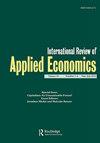衡量金融服务中的企业多样性:多样性指数
IF 1.6
Q3 ECONOMICS
引用次数: 2
摘要
摘要本文提供了一种衡量金融服务企业多样性的方法。我们的指数基于四个组成部分:所有权;竞争力资产负债表结构/弹性;以及地理分布。这些子指数中的第一个是基于多样化的贝里指数和生物多样性的基尼-辛普森指数来衡量所有权多样性。它捕捉到了所有权类型的多样性程度——对于英国、银行、互助银行和政府所有的国民储蓄与投资——其中每一种都有不同的目标,创造了行为的多样性。我们的第二个子指数反映了竞争的程度,并基于赫希曼-赫芬达尔集中度指数的倒数。我们的第三个分类指数衡量了整个金融部门资产负债表结构的多样性和弹性。我们的最终分类指数反映了金融服务的地理分布程度和区域集中度。这些指标被组合成一个单一的指数——D指数——衡量金融服务的多样性。D指数显示,在2007-2009年金融危机之前,该指数显著下降,随后在2008年和2009年进一步下跌。自那以后,该指数基本持平。为了避免2007-2009年全球金融危机的重演,我们还没有接近创造多样性的条件。本文章由计算机程序翻译,如有差异,请以英文原文为准。
Measuring corporate diversity in financial services: a diversity index
ABSTRACT This paper provides a measure of corporate diversity in financial services. Our index is based on four components: ownership; competitiveness; balance sheet structure/resilience; and geographic spread. The first of these sub-indexes measures ownership diversity based on the Berry index of diversification and the Gini-Simpson index of biodiversity. It captures the extent of diversity in ownership types – for the UK, banks, mutuals, and the government owned National Savings & Investment – where each of these have different objectives, creating diversity in behaviour. Our second sub-index captures the extent of competition, and is based on the inverse of the Hirschmann-Herfindahl index of concentration. Our third sub-index measures diversity in balance sheet structures and resilience across the financial sector. Our final sub-index captures the extent of geographic spread and the regional concentration of financial services. These indicators are combined into a single index – the D-Index – that measures diversity in financial services. The D-Index shows a marked decline in the run-up to the 2007–2009 financial crisis, followed by further falls during 2008 and 2009. Since then, the index has remained more or less flat. We are no closer to creating the conditions – of diversity – to avoid a repeat of the 2007-2009 global financial crisis.
求助全文
通过发布文献求助,成功后即可免费获取论文全文。
去求助
来源期刊

International Review of Applied Economics
ECONOMICS-
CiteScore
4.30
自引率
4.50%
发文量
37
期刊介绍:
International Review of Applied Economics is devoted to the practical applications of economic ideas. Applied economics is widely interpreted to embrace empirical work and the application of economics to the evaluation and development of economic policies. The interaction between empirical work and economic policy is an important feature of the journal. The Journal is peer reviewed and international in scope. Articles that draw lessons from the experience of one country for the benefit of others, or that seek to make cross-country comparisons are particularly welcomed. Contributions which discuss policy issues from theoretical positions neglected in other journals are also encouraged.
 求助内容:
求助内容: 应助结果提醒方式:
应助结果提醒方式:


